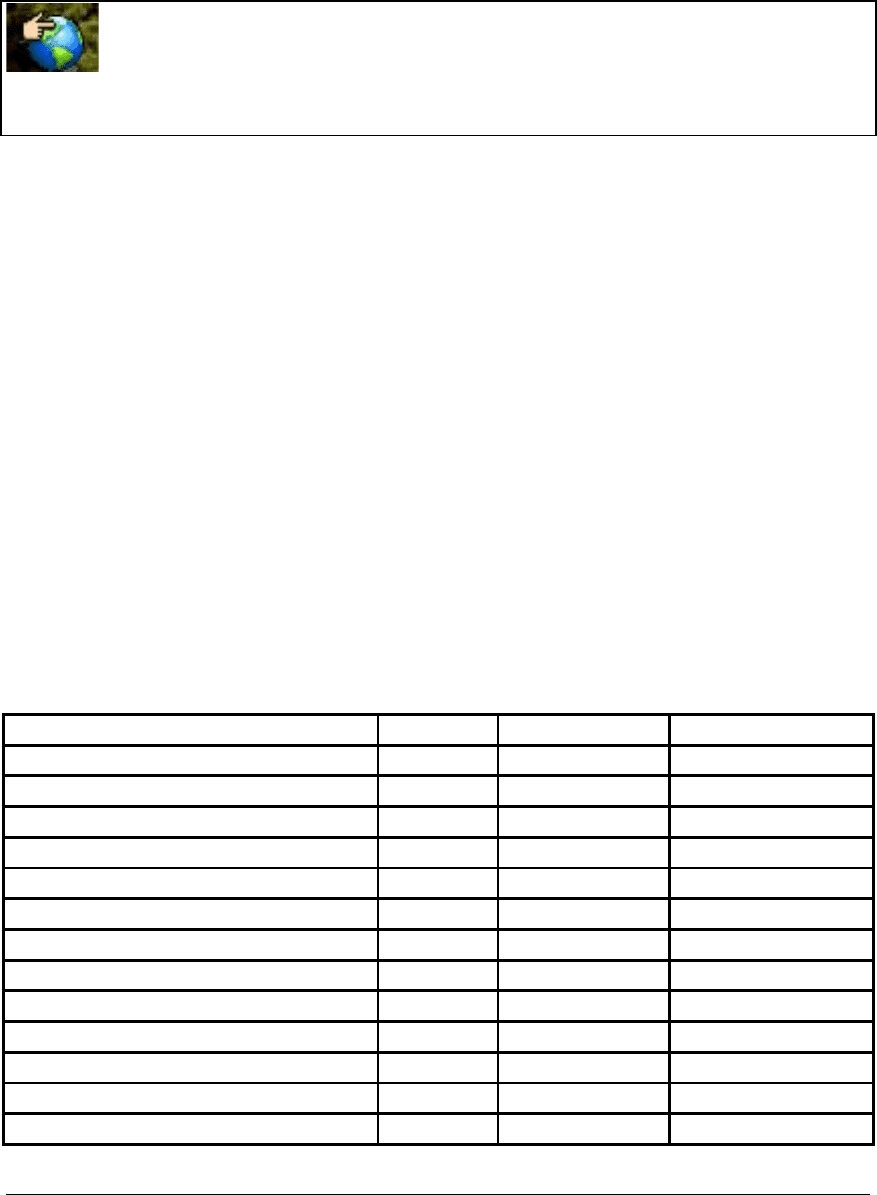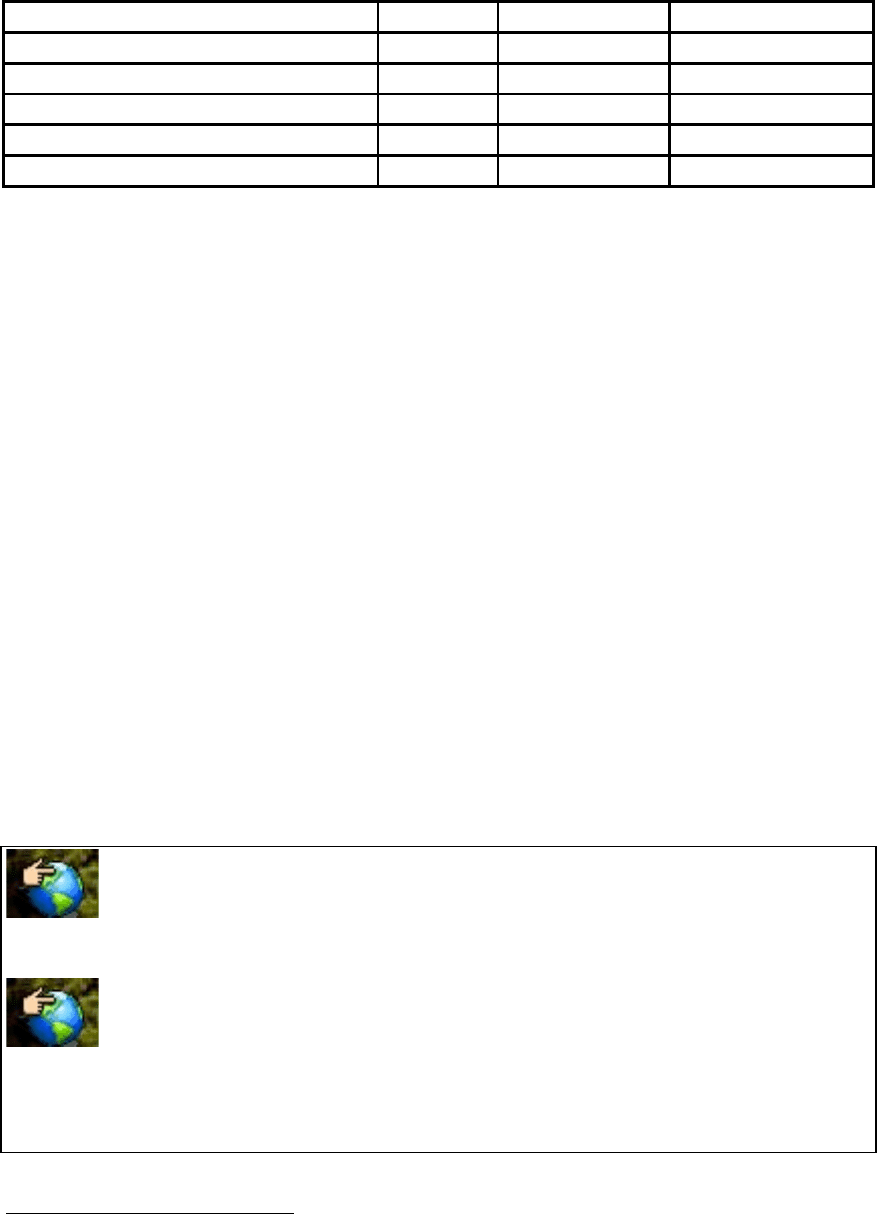Damodaran A. Applied corporate finance
Подождите немного. Документ загружается.


67
67
Univision Communic.
UVN
122.76
24.50%
5.01
Salem Communications Corp
SALM
145.67
28.75%
5.07
Average for sector
47.08
17.17%
2.74
Source: Value Line
This simple view of multiples leads us to conclude that Disney should trade at 47.08
times earnings, since that is the average for similar publicly traded firms. The resulting
value for the equity would be:
Value of Equity = Disney net income in 2003* Average PE ratio for sector
= $1,267 million * 47.08 = $59,650 million
In this valuation, we assume that Disney has a growth rate similar to the average for the
sector. One way of bringing growth into the comparison is to compute the PEG ratio,
which is reported in the last column. Based on the average PEG ratio of 2.79 for the
sector and the analyst estimate of growth in earnings of 12% for the next 5 years, we
obtain the following value for the equity in Disney:
Value of Equity = $ 1,267 million * 2.79 * 12 = $ 41,692 million
While this may seem like an easy adjustment to resolve the problem of differences across
firms, the conclusion holds only if these firms are of equivalent risk. Implicitly, this
approach assumes a linear relationship
39
between growth rates and PE.
12.11. ☞: Underlying Assumptions in Comparable Valuation
Assume that you are reading an equity research report where a buy recommendation for a
company is being based upon the fact that its PE ratio is lower than the average for the
industry. Implicitly, what is the underlying assumption or assumptions being made by
this analyst?
a. The sector itself is, on average, fairly priced
b. The earnings of the firms in the group are being measured consistently
c. The firms in the group are all of equivalent risk
d. The firms in the group are all at the same stage in the growth cycle
e. The firms in the group are of equivalent risk and have similar cash flow patterns
f. All of the above

68
68
pe.xls: There is a dataset on the web that summarizes PE ratios and PEG ratios
by industry group in the United States for the most recent quarter.
b. Adjusting for more than one variable
When firms differ on more than one variable, it becomes difficult to modify the
multiples to account for the differences across firms. We can run regressions of the
multiples against the variables and then use these regressions to find predicted values for
each firm. This approach works reasonably well when the number of comparable firms is
large and the relationship between the multiple and the variables is stable. When these
conditions do not hold, a few outliers can cause the coefficients to change dramatically
and make the predictions much less reliable.
Illustration 12.15: Price to Book Value Ratios and Return on Equity: European Banks
Table 12.9 lists price/book value ratios of European banks and reports on their
returns on equity and risk levels (measured using the standard deviation in stock prices
over the previous 5 years):
Table 12.9: European Banks: Price to Book Value Ratio – 2003
Name
PBV Ratio
Return on Equity
Standard Deviation
Bayerische Hypo-Und Vereinsb
0.80
-1.66%
49.06%
Commerzbank Ag
1.09
-6.72%
36.21%
Deutsche Bank Ag -Reg
1.23
1.32%
35.79%
Banca Intesa Spa
1.66
1.56%
34.14%
Bnp Paribas
1.72
12.46%
31.03%
Banco Santander Central Hisp
1.86
11.06%
28.36%
Sanpaolo Imi Spa
1.96
8.55%
26.64%
Banco Bilbao Vizcaya Argenta
1.98
11.17%
18.62%
Societe Generale
2.04
9.71%
22.55%
Royal Bank Of Scotland Group
2.09
20.22%
18.35%
Hbos Plc
2.15
22.45%
21.95%
Barclays Plc
2.23
21.16%
20.73%
Unicredito Italiano Spa
2.30
14.86%
13.79%
39
Only by assuming a linear relationship can we compare the PEG ratio of a 10% growth firm to a 20%
growth firm.

69
69
Kredietbank Sa Luxembourgeoi
2.46
17.74%
12.38%
Erste Bank Der Oester Spark
2.53
10.28%
21.91%
Standard Chartered Plc
2.59
20.18%
19.93%
Hsbc Holdings Plc
2.94
18.50%
19.66%
Lloyds Tsb Group Plc
3.33
32.84%
18.66%
Sector Average
2.05
12.54%
24.99%
Source: Bloomberg
Since these firms differ on both risk and return on equity, we run a regression of PBV
ratios on both variables:
PBV = 2.27 + 3.63 ROE -2.68 Standard Deviation R
2
= 79.48%
(5.56) (3.32) (2.32)
Firms with higher return on equity and lower standard deviations trade at much higher
price to book ratios. The numbers in brackets are t-statistics and suggest that the
relationships between PBV ratios and both variables in the regression are statistically
significant. The R-squared indicates the percentage of the differences in PBV ratios that
is explained by the independent variables. Finally, the regression
40
itself can be used to
get predicted PBV ratios for the companies in the list. Thus, the predicted PBV ratio for
Deutsche Bank, based upon its return on equity of 1.32% and its standard deviation of
35.79%, would be 1.36.
Predicted PBV
Deutsche Bank
= 2.27 + 3.63 (.0132) – 2..68 (.3579) = 1.36
Since the actual PBV ratio for Deutsche Bank at the time of the analysis was 1.23, this
would suggest that the stock is undervalued by roughly 10%.
pbv.xls: There is a dataset on the web that summarizes price to book ratios and
returns on equity by industry group in the United States for the most recent quarter.
ps.xls: There is a dataset on the web that summarizes price to sales ratios and
margins by industry group in the United States for the most recent quarter.
40
Both approaches described above assume that the relationship between a multiple and the variables
driving value are linear. Since this is not always true, we might have to run non-linear versions of these
regressions.
70
70
3. Expanding the Range of Comparable Firms
Searching for comparable firms within the sector in which a firm operates is fairly
restrictive, especially when there are relatively few firms in the sector or when a firm
operates in more than one sector. Since the definition of a comparable firm is not one that
is in the same business but one that has the same growth, risk and cash flow
characteristics as the firm being analyzed, we need not restrict our choice of comparable
firms to those in the same industry. A software firm should be comparable to an
automobile firm, if we can control for differences in the fundamentals.
The regression introduced in the previous section allows us to control for
differences on those variables that we believe cause multiples to vary across firms. Based
upon the variables listed in Table 12.7, we should be able to regress PE, PBV and PS
ratios against the variables that should affect them:
Price Earnings = f (Growth, Payout ratios, Risk)
Price to Book Value = f (Growth, Payout ratios, Risk, ROE)
Price to Sales = f (Growth, Payout ratios, Risk, Margin)
It is, however, possible that the proxies that we use for risk (beta), growth (expected
growth rate), and cash flow (payout) may be imperfect and that the relationship may not
be linear. To deal with these limitations, we can add more variables to the regression -
e.g., the size of the firm may operate as a good proxy for risk - and use transformations of
the variables to allow for non-linear relationships.
We ran these regressions
41
for PE, PBV, and PS ratios across publicly listed firms
in the United States in January 2004 against analyst estimates of expected growth in
earnings per share and other financial indicators from the most recent year. The sample,
which had more than 7000 firms in it, yielded the regressions reported below. These
regressions can then be used to get predicted PE, PBV, and PS ratios for each firm,
which, in turn, can be compared to the actual multiples to find under and over valued
firms.
PE = 9.475 + 0.814 Expected growth + 0.06 Payout + 6.283 Beta (R2 = 22.1%)
PBV= 0.140 ROE + 0.599 Beta + 0.08 Expected Growth +.002 Payout (R2= 47.1%)

71
71
PS= 0.04 Expected Growth +0.011 Payout + 0.549 Beta + 0.234 Net Margin (R2=
71.0%)
The first advantage of this approach over the “subjective” comparison across
firms in the same sector, described in the previous section, is that it does quantify, based
upon actual market data, the degree to which higher growth or risk should affect the
multiples. It is true that these estimates can be noisy, but noise is a reflection of the
reality that many analysts choose not to face when they make subjective judgments.
Second, by looking at all firms in the market, this approach allows us to make more
meaningful comparisons of firms that operate in industries with relatively few firms.
Third, it allows us to examine whether all firms in an industry are under- or overvalued,
by estimating their values relative to other firms in the market.
Illustration 12.16: Applying Market Regression to Estimate Multiples - Disney
We will use the results of the market regression summarized above to estimate the
appropriate value for Disney. Consider the regression for the PE ratio:
PE = 9.475 + 0.814 Expected growth + 0.06 Payout + 6.283 Beta
The corresponding values for Disney are as follows:
Expected Growth rate = 12.00% (Analyst consensus estimate for EPS growth)
Payout Ratio = 32.31%
Beta = 1.2456
The estimated price earnings ratio for Disney is:
PS = 9.475 + 0.814 (12) + 0.06 (32.31) + 6.283 (1.2456) = 29.01
Since Disney trades at an actual PE ratio of 29.87, it is slightly overvalued, relative to the
market, by about 3%.
multregr.xls: This dataset summarizes the latest regression of multiples against
fundamentals for the United States for the most recent quarter.
41
We ran the regression using absolute values for the independent variables and both with intercepts and
without intercepts. .If the intercept is negative, we have reported the regression without the intercept.
72
72
Reconciling Different Valuations
The two approaches to valuation – discounted cash flow valuation and relative
valuation – yield different values for Disney
42
. In fact, Disney is significantly overvalued
using a discounted cashflow model but is closer to being fairly valued using relative
valuation models. Even within relative valuation, we arrive at different estimates of
value, depending upon which multiple we use and what firms we based the relative
valuation on.
The differences in value between discounted cash flow valuation and relative
valuation come from different views of market efficiency, or put more precisely, market
inefficiency. In discounted cash flow valuation, we assume that markets make mistakes,
that they correct these mistakes over time, and that these mistakes can often occur across
entire sectors or even the entire market. In relative valuation, we assume that while
markets make mistakes on individual stocks, they are correct on average. In other words,
when we value Disney relative to other entertainment companies, we are assuming that
the market has priced these companies correctly, on average, even though it might have
made mistakes in the pricing of each of them individually. Thus, a stock may be over
valued on a discounted cash flow basis but under valued on a relative basis, if the firms
used in the relative valuation are all overpriced by the market. The reverse would occur,
if an entire sector or market were underpriced.
To conclude, we suggest the following broad guidelines on gauging value using
different approaches:
• The discounted cash flow models are built on the implicit assumption of long
time horizons, giving markets time to correct their errors.
• When using relative valuation, it is dangerous to base valuations on multiples
where the differences across firms cannot be explained well using financial
fundamentals – growth, risk, and cash flow patterns. One of the advantages of
using the regression approach described in the later part of this chapter is that
the R-squared and t-statistics from the regressions yield a tangible estimate of
the strength (or weakness) of this relationship.

73
73
12.12. ☞: Valuing an Initial Public Offering
If you were an investment banker, pricing an initial public offering, would you primarily
use discounted cash flow valuation, relative valuation or a combination of the two?
a. Relative valuation, because the buyers of the IPO will look at comparables
b. Discounted cash flow valuation, because it reflects intrinsic value
c. The higher of the two values, since it is my job to get the highest price I can for my
client
d. None of the above
Explain.
Conclusion
There are two basic approaches to valuation. The first is discounted cash flow
valuation, where the value of any asset is estimated by computing the present value of the
expected cash flows on it. The actual process of estimation, in either case, generally
requires four inputs –
• the length of the period for which a firm or asset can be expected to generate growth
greater than the stable growth rate (which is constrained to be close to the growth rate
of the economy in which the firm operates),
• the cash flows during the high growth period,
• the terminal value at the end of the high growth period and
• a discount rate.
The expected growth potential will vary across firms, with some firms already growing at
a stable growth rate and others for which the expectation, at least, is that growth will last
for some period into the future. We can value the operating assets of a firm by
discounting cashflows before debt payments, but after reinvestments, at the cost of
capital. Adding the value of cash and non-operating assets give us firm value, and
subtracting out debt yields the value of equity. We can also value equity directly by
discounting cash flows after debt payments and reinvestment needs at the cost of equity.
42
Kaplan and Ruback (1995) examine valuations in acquisitions and find that discounted cash flow models
better explain prices paid than relative valuation models.
74
74
The other approach to valuation is relative valuation, where the value of any asset
is estimated by looking at how “similar” assets are priced in the market. The key steps in
this approach are defining “comparable” firms or assets and choosing a standardized
measure of value (usually value as a multiple of earnings, cash flows or book value) to
compare the firms. To compare multiples across companies, we have to control for
differences in growth, risk and cash flows, just as we would have in discounted cash flow
valuation.
75
75
Live Case Study
Valuation
Objective: To value your firm, based upon its existing management, and your
expectations for the future.
Key Questions:
• What type of cash flow (dividends, FCFE or FCFF) would you choose to discount for
this firm?
• What growth pattern would you pick for this firm? How long will high growth last?
• What is your estimate of value of equity in this firm? How does this compare to the
market value?
Framework for Analysis:
1. Cash Flow Estimation
• What is this firm’s accounting operating income? Would you adjust it for your
valuation?
• What is your firm’s effective tax rate? What is its marginal tax rate? Which
would you use in your valuation?
• How much did your firm reinvest last year in internal investments,
acquisitions, R&D and working capital?
2. Growth Pattern Choice
• How fast have this company’s earnings grown historically?
• How fast do analysts expect this company’s earnings to grow in the future?
• What do the fundamentals suggest about earnings growth at this company?
(How much is being reinvested and at what rate of return?)
• If there is anticipated high growth, what are the barriers to entry that will
allow this high growth to continue? For how long?
3. Valuation
• What is the value of the operating assets of the firm, based upon a discounted
cash flow model?
• Does the firm have cash and non-operating assets and what is their value?

76
76
• Are there equity options outstanding (management options, convertible bonds)
and how much are they worth?
• What is the value of equity per share?
4. Relative Valuation
• What multiple would you use to value the firm or its equity?
• What industry does the firm belong to, and what are the comparable firms?
• How does your firm’s valuation (in multiple terms) compare to those of the other
firms in the industry?
• What value would you assign your firm (or its equity), given how comparable firms
are valued?
Getting Information for valuation
Most of the information that you need for valuation come from your current or
past financial statements. You will also need a beta (see risk and return section) and a
debt ratio (see risk and return section) to estimate the free cash flows to equity. You can
get analyst estimates of growth in several sources including Zacks and I/B/E/S.
Online sources of information:
http://www.stern.nyu.edu/~adamodar/cfin2E/project/data.htm
